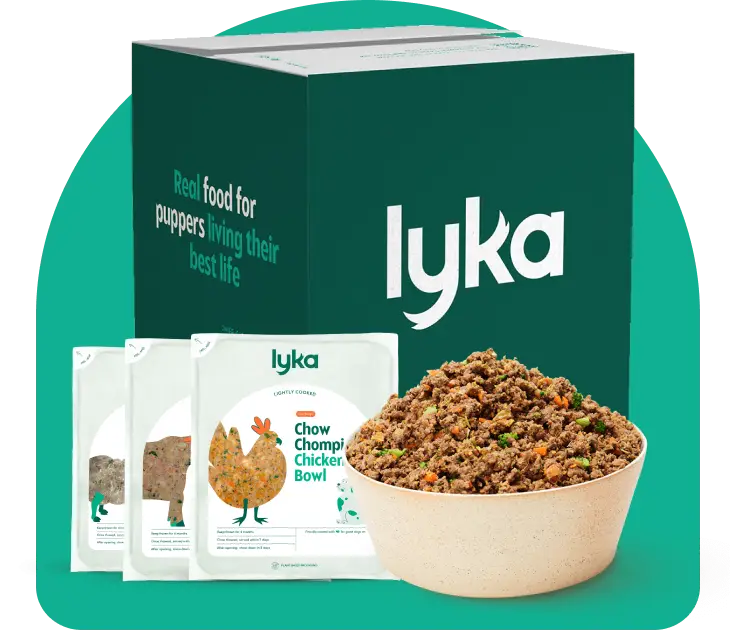Dogs aren’t carnivores. Yes, you heard us right!
In fact, too much protein can be bad for dogs. They may be descended from wolves but our furry friends are actually omnivores, like us.
If this is news to you, don’t worry — there are a lot of myths and misconceptions about dog food out there.
Nourishing your pup with the right food is a no-brainer, but getting your head around nutrition can be tricky.
We dig into the common misconceptions about dog nutrition, so you have direct access to all the facts you need to help you make the best decisions for your best friend.
Myth #1: Carbohydrates are a great source of energy
Dogs need energy to fuel their bodies (and their zoomies), but do they need carbohydrates to provide this energy?
Mythbuster:
High-GI carbohydrates like rice, potatoes, wheat, soy, corn and legumes can cause spikes in their blood-glucose levels creating a burst of energy followed by a slump — a bit like how you feel after a heavy meal.
This sudden increase in glucose can also put the pancreas under stress as it rapidly releases insulin to restore balance — a common trigger for pancreatitis.
A whopping 40% of dogs in Australia are reported as overweight or obese and it’s on the rise. Low-quality diets that contain excessive amounts of high-GI carbs are one of the culprits behind this worrying statistic.
Research has shown a potential link between high-GI carbohydrates and atopic dermatitis, and other studies in mice have shown their ability to trigger a chronic inflammatory response contributing to diabetes, heart disease, arthritis and cancer.
Fat and protein are better sources of energy because they’re more calorific and dogs can convert these macronutrients into glucose using their own metabolic pathways.
Fats are also essential for other bodily functions, like:
Vitamin absorption
Blood clotting
Signalling between cells
Pain management
Inflammation management
A high-protein, low-carbohydrate diet using low-GI ingredients is an effective way to maintain your pup’s healthy weight and provides slow-release energy without the sugar rush.
Myth #2: The more protein the better
Dogs should only be fed protein and the more the better, right? Well, not quite.
Mythbuster:
All pups require protein to function, that’s true. It performs a long list of functions from tissue repair to supporting their immune defence.
Too much protein can put the kidneys under strain. A dog’s body will only use the protein it needs, and any excess is processed by the kidneys and excreted in urine.
If you’ve noticed burnt patches on your lawn, or your pup is gaining weight or has regular diarrhoea, these may be signs of too much protein in their food.
Not all proteins are the same, either. Many processed dry food brands promote a high protein percentage, but it’s often predominantly plant proteins, like legumes, rather than animal protein.
Although small amounts of legumes do have some health benefits, the quantities in many kibble brands are significantly higher, increasing the risk of dilated cardiomyopathy (DCM) and digestive problems.
Myth #3: Dogs shouldn’t eat fruit or vegetables
A widely held assumption is that dogs have no nutritional need for vegetables or fruit in their diet because they’re meat-eaters. This isn’t true!
Mythbuster:
Our domesticated and pampered pooches are a far cry from their wild wolf ancestors and their systems have adjusted over time too — they’re omnivores, not carnivores.
While high-quality animal protein contains many of your dog’s daily macro and micronutrients, adding fruit and vegetables to your pup’s diet has multiple health benefits:
Phytochemicals boost their immune system and protect against toxins and diseases.
A wide variety of plant foods can improve the diversity and function of their microbiome, vital for overall health and wellbeing.
The soluble and insoluble fibre in fruit and vegetables help maintain a healthy digestive system and prevent constipation.
They make tasty and healthy snacks and treats that nourish their bodies and promote satiety.
Even wolves and wild dogs eat plants and fruit when they ingest their prey’s innards — they’re not strictly carnivorous.
If you’re wondering which fruit and vegetables your dog can eat, check out our ingredients list which also includes a breakdown of the health benefits of each food.
Myth #4: Dogs need grains to prevent heart disease
To be grain-free or not to be grain-free; it’s a hotly-debated question.
Humans have been encouraged to switch from refined to whole grains to reduce cholesterol levels and the risk of heart disease. But is the principle the same for dogs?
Mythbuster:
Dogs can eat grains but they don’t need them to prevent heart disease.
It’s more important to avoid ultra-processed food that has a high proportion of legumes as these ingredients contain anti-nutrients that hinder the body’s ability to produce heart-protecting substances, like taurine.
Myth #5: All Omega fatty acids are good for dogs
You’ve probably heard the buzz around the benefits of Omega fatty acids for humans and dogs alike. But are all Omega fatty acids the same and are they good for dogs?
Mythbuster:
There are three main Omega fatty acids: Omega-3, Omega-6 and Omega-9.
Omega-9 can be synthesised by your dog’s body, so it isn’t an essential fatty acid. But Omega-3 and Omega-6 can only be absorbed through diet and are vital macronutrients for your furry friend’s health.
Omega-3 has multiple health benefits for dogs like improving heart health, reducing inflammation and managing blood pressure. It’s found in fish, nuts, leafy vegetables and flaxseeds.
Omega-6 is a bit more complex: it provides energy but it also has pro-inflammatory agents. It’s found in vegetable oils, seeds and nuts.
A complete and balanced diet should contain the right ratio of Omega-3 and Omega-6 to provide all the right qualities without promoting inflammation.
The AAFCO recommends an Omega-6: Omega-3 ratio of 30:1 but we’ve chosen a much lower ratio of between 2:1 and 3.6:1 based on the clinical insights and research of our Veterinary Nutritionist and our in-house holistic Veterinarian, Dr. Matthew Muir.
Myth #6: Added vitamins and minerals are always synthetic
Dry dog food is cooked at high temperatures often exceeding 200℃. Most vitamins and minerals are heat-sensitive, so these extreme temperatures affect their potency. Synthetic vitamins and minerals usually have to be added to kibble to improve its nutrient density.
Mythbuster:
Vitamins and minerals from wholefood sources are highly digestible and bioavailable and there’s no need to add artificial nutrients to fresh, lightly cooked food as the natural nutrients aren’t destroyed in the process.
Natural vitamins and minerals mean you know exactly which ingredients have been selected for their nutritional content, rather than a list of confusing chemical additives on the back of the packet.
Myth #7: The Australian pet food industry is heavily regulated
Did you know the Australian pet food industry is largely unregulated?
The Pet Food Industry Association of Australia (PFIAA) has established Australian Pet Food Standards for manufacturing and labelling, but it’s voluntary and up to each company to self-regulate. There’s no governing body that regulates the industry to hold companies accountable to the standards.
What that means for you as a pupper parent is you can’t be assured of the quality of dog food produced in Australia, from the ingredients to the manufacturing process. Sadly, this has led to the deaths of some dogs who were exposed to toxins present in knackery meat used in dog food.
Mythbuster:
Australia may not have a regulatory board to monitor the quality of dog food, but you can look for brands that meet the Association of American Feed Control Officials (AAFCO) and European Pet Food Industry Association (FEDIAF) standards, as a minimum.
Even better, choose human-grade dog food.
Lyka recipes are made from 100% human-grade ingredients that we taste-test ourselves! Yes, you heard right. If we won’t eat it, we won’t give it to our pups — it’s that simple.
Myth #8: Dogs don’t need human-grade ingredients
The Australian pet food industry is self-regulated meaning any parts of the animal can be used in dog food.
If you look at the ingredients in many dry dog food brands you might notice contents like meat meal or meat by-products. These ‘meat’ ingredients are the bits left over once the parts for human consumption have been removed and can include bone, blood, stomach contents, hair and hooves. They’re rendered at very high temperatures and ground into a dry meal.
Sounds delicious, right?
Mythbuster:
Human-grade ingredients are strictly regulated and require a HACCP or ISO 9001 certification. They’re tested for pathogens like salmonella and E. coli, and food production processes are tightly controlled.
Scientific research has shown that human-grade dog food is more digestible leading to a healthier and more diverse gut microbiome and smaller poos.
To guarantee the quality and digestibility of the ingredients in your dog’s food, they should be human-grade.
Lyka: our transparent food philosophy
At Lyka, we believe that you should know exactly what’s in your dog’s food, so there’s no question about what they’re eating — transparency is key. That’s why we list all of our ingredients and their health benefits. There’s nothing hidden and no nasty surprises!
The ultimate satisfaction comes from knowing that everything in our recipes is of the highest quality and has been deliberately chosen for your pupper’s health and wellbeing.
From high-quality proteins to the freshest fruit and vegetables, jam-packed with vitamins and minerals. You can even try it yourself!
)
)
)

)
)
)
)
